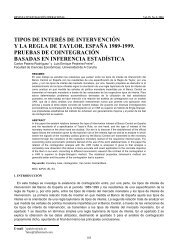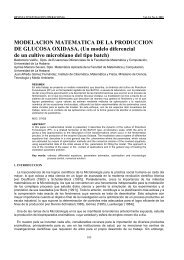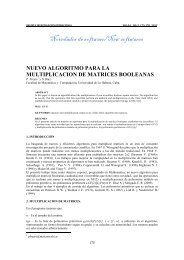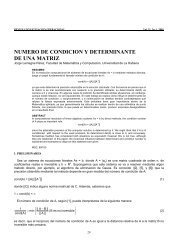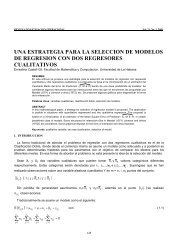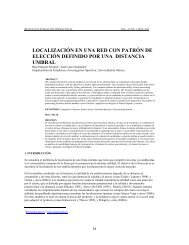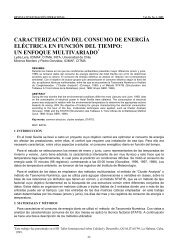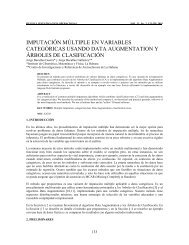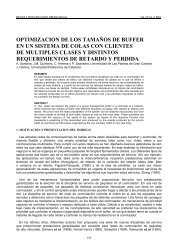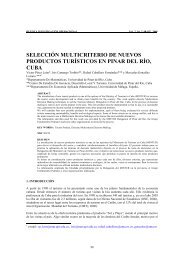una presentacion de los minimos cuadrados generalizados, y
una presentacion de los minimos cuadrados generalizados, y
una presentacion de los minimos cuadrados generalizados, y
Create successful ePaper yourself
Turn your PDF publications into a flip-book with our unique Google optimized e-Paper software.
REVISTA INVESTIGACIÓN OPERACIONAL VOL., 32 , NO. 1, 67-89, 2011<br />
Noveda<strong>de</strong>s <strong>de</strong> software/New softwares<br />
UNA PRESENTACION DE LOS MINIMOS<br />
CUADRADOS GENERALIZADOS, Y EN<br />
PARTICULAR, PARA FUNCIONES VECTORIALES<br />
Jorge Lemagne Pérez 1<br />
Departamento <strong>de</strong> Matemática Aplicada Facultad <strong>de</strong> Matemática y Computación, Universidad <strong>de</strong> La Habana<br />
ABSTRACT<br />
In this communication, a critical bibliographical survey on discrete least squares (LS) presentation is firstly ma<strong>de</strong>, and<br />
especially of data fitting (DF).<br />
Afterwards, to help to overcome part of the limitations and <strong>de</strong>ficiencies that were shown in the bibliography, a formal<br />
presentation of generalized least squares (GLS, in general non linear by <strong>de</strong>fault) is ma<strong>de</strong>, and very especially of DF for vector<br />
valued functions (VVF); the corresponding non linear system of equations, extension of the well known normal equations, is<br />
<strong>de</strong>rived. From there, some particular cases are obtained, for example, when the function is real valued, and when the<br />
approximation is linear. This second example is just linear generalized least squares (LGLS).<br />
KEY WORDS: Data fitting, least squares, multivariate methods, normal equations, Generalized least squares<br />
MSC: 65F30<br />
RESUMEN<br />
En esta comunicación se hace, primeramente, <strong>una</strong> revisión crítica <strong>de</strong> cómo se presenta el tema <strong>de</strong> mínimos <strong>cuadrados</strong> (MC, se<br />
sobrentien<strong>de</strong> discretos) en la bibliografía existente, y en particular, <strong>de</strong>l ajuste <strong>de</strong> datos (AD).<br />
Posteriormente, para contribuir a superar parte <strong>de</strong> las limitaciones y <strong>de</strong>ficiencias señaladas en la revisión bibliográfica, se hace<br />
<strong>una</strong> exposición formal <strong>de</strong>l problema <strong>de</strong> mínimos <strong>cuadrados</strong> <strong>generalizados</strong> (MCG, se sobrentien<strong>de</strong> no lineales en general), y muy<br />
en especial <strong>de</strong>l AD para funciones vectoriales (FV); se <strong>de</strong>duce el sistema no lineal <strong>de</strong> ecuaciones correspondiente, extensión <strong>de</strong>l<br />
conocido sistema <strong>de</strong> ecuaciones normales. A partir <strong>de</strong> ahí se <strong>de</strong>ducen algunos casos particulares, entre el<strong>los</strong>, cuando la función<br />
toma valores reales, y cuando la función <strong>de</strong> aproximación es lineal, o sea mínimos <strong>cuadrados</strong> <strong>generalizados</strong> lineales (MCGL).<br />
1. INTRODUCCION. UNA REVISIÓN BIBLIOGRÁFICA CRÍTICA SOBRE MÍNIMOS<br />
CUADRADOS<br />
Por su importancia, <strong>los</strong> MC son tratados con gran frecuencia en numerosas publicaciones científicas y técnicas.<br />
Es necesario señalar que el problema <strong>de</strong> MC es conocido bajo diferentes nombres en varias ramas; por<br />
ejemplo, en Estadística se le llama análisis <strong>de</strong> regresión, y en Ingeniería, estimación <strong>de</strong> parámetros, filtraje o<br />
i<strong>de</strong>ntificación <strong>de</strong> procesos.<br />
De acuerdo con <strong>los</strong> objetivos <strong>de</strong> la presente investigación, resulta conveniente hacer – en primer lugar – <strong>una</strong><br />
revisión crítica <strong>de</strong> diferentes <strong>presentacion</strong>es <strong>de</strong> este tema, y específicamente sobre AD. Dentro <strong>de</strong> la<br />
bibliografía existente, se consultaron no menos <strong>de</strong> 140 publicaciones (vea 9).<br />
Primeramente nos referiremos al problema <strong>de</strong> AD mediante MCP, <strong>de</strong>spués se aborda MCG para funciones que<br />
toman valores escalares, y posteriormente MCG para FV, culminando <strong>de</strong> esta manera con el caso general en<br />
que se quieran aproximar funciones<br />
p q<br />
f : ℜ → ℜ , p ≥1<br />
, q ≥ 1.<br />
(1.1)<br />
A partir <strong>de</strong> toda esta panorámica se <strong>de</strong>stacan las limitaciones <strong>de</strong> <strong>los</strong> enfoques en las publicaciones, incluyendo<br />
un breve ejemplo práctico para resaltar dichas insuficiencias.<br />
1 lemagne@matcom.uh.cu<br />
67
El software existente sobre MCG será analizado en <strong>una</strong> publicación posterior.<br />
1.1.Ajuste <strong>de</strong> datos mediante mínimos <strong>cuadrados</strong> pon<strong>de</strong>rados<br />
Aquí po<strong>de</strong>mos suponer, sin pérdida <strong>de</strong> generalidad, que q = 1 .<br />
En particular, el caso lineal es clásico <strong>de</strong>ntro <strong>de</strong>l Análisis Numérico, no presenta dificulta<strong>de</strong>s (<strong>de</strong>s<strong>de</strong> el punto<br />
<strong>de</strong> vista teórico), y existen programas para computadoras que lo resuelven. Es abundante la bibliografía don<strong>de</strong><br />
el problema <strong>de</strong> MC se trata a lo sumo con ese enfoque, pero tomando p = 1;<br />
véase por ejemplo las obras <strong>de</strong><br />
Berezin [1971], Gautschi [1997], Gill et al [1990], González [1983], Guerra et al [1987], Isaacson y Keller<br />
[1971], Kincaid et al [1995], Ralston [1965], Sastre [1988] y Volkov [1990]; en la inmensa mayoría <strong>de</strong> <strong>los</strong><br />
casos se consi<strong>de</strong>ra la función <strong>de</strong> peso como la constante 1, lo que lo convierte en un problema <strong>de</strong> mínimos<br />
<strong>cuadrados</strong> ordinarios (MCO).<br />
Específicamente González y Guerra sólo consi<strong>de</strong>ran ajustes mediante rectas, e Isaacson y Keller mediante<br />
polinomios y polinomios trigonométricos.<br />
Otros casos más generales son menos estudiados:<br />
1. El caso no lineal no aparece tratado con tanta frecuencia en la bibliografía:<br />
Aquí incluiremos las publicaciones <strong>de</strong> Tellinghuisen [2005] y Rufino et al [2005].<br />
Un clásico como Forsythe et al [1972] hace <strong>una</strong> breve incursión cuando p = 1 y señala que se limitará a la<br />
aproximación <strong>de</strong> funciones <strong>de</strong> <strong>una</strong> variable real, ya que la teoría <strong>de</strong> la aproximación <strong>de</strong> funciones <strong>de</strong> varias<br />
variables no está bien <strong>de</strong>sarrollada. Carleton parte <strong>de</strong> que p = 1.<br />
Se consi<strong>de</strong>ra fundamentalmente el caso<br />
lineal, pues el no lineal apenas se estudia. Koroliuk [1981] se limita a formular el problema. Es interesante<br />
señalar que Bolshakov [1989] en caso necesario linealiza el problema mediante serie <strong>de</strong> Taylor. Raíces [1986]<br />
consi<strong>de</strong>ra <strong>de</strong> manera restringida el or<strong>de</strong>n <strong>de</strong> la aproximación, aunque posteriormente sí hace el <strong>de</strong>sarrollo<br />
general para <strong>de</strong>ducir el sistema no lineal <strong>de</strong> ecuaciones que hay que resolver. El libro <strong>de</strong> Motulski y<br />
Christopou<strong>los</strong> [2003] está orientado a <strong>los</strong> investigadores y es muy práctico; la regresión múltiple sólo la trata<br />
ligeramente. En Mahata [2003] se exploran propieda<strong>de</strong>s estadísticas asintóticas <strong>de</strong> <strong>los</strong> estimados obtenidos<br />
mediante mínimos <strong>cuadrados</strong> no lineales separables.<br />
2. El caso lineal p ≥1<br />
, naturalmente aparece más tratado, pero sin la suficiente generalidad y sistematización:<br />
Forsythe et al casi sólo menciona la regresión múltiple y no profundiza en ella. En Linares [1986] y Suárez<br />
[1988] aparecen algunos casos <strong>de</strong> aproximación lineal multivariada, pero esto no se enfoca <strong>de</strong>ductivamente a<br />
partir <strong>de</strong> <strong>una</strong> aproximación lineal general (con p variables in<strong>de</strong>pendientes). Cué, Castell, [1987], Cué et al<br />
[1985] aunque consi<strong>de</strong>ran funciones <strong>de</strong> regresión más generales que <strong>los</strong> dos autores anteriores, tampoco las<br />
enfocan como casos particulares <strong>de</strong> aproximación lineal general.<br />
En Tamayo [1984] sí aparece un análisis bastante general <strong>de</strong> este caso, pero no se dice explícitamente que se<br />
p<br />
trabaja con funciones <strong>de</strong>ℜ<br />
en ℜ , ni se expresa la matriz <strong>de</strong>l sistema <strong>de</strong> ecuaciones normales en términos <strong>de</strong><br />
<strong>los</strong> productos escalares <strong>generalizados</strong> a este tipo <strong>de</strong> funciones. Tampoco se estudian las propieda<strong>de</strong>s <strong>de</strong> dicho<br />
sistema <strong>de</strong> ecuaciones lineales. Keller [2002] y Stanford [2000] tratan el caso particular <strong>de</strong> MCO, a partir<br />
directamente <strong>de</strong> <strong>los</strong> elementos <strong>de</strong> la matriz <strong>de</strong>l sistema sobre<strong>de</strong>terminado, y por tanto no necesitan tomar en<br />
cuenta a p . Hager [1988], Koroliuk [1981], Lawson [1995] y Wilkinson [1971] también consi<strong>de</strong>ran MCO,<br />
pero sin hacer referencia explícita alg<strong>una</strong> a función empírica. Entonces, como primera conclusión, po<strong>de</strong>mos<br />
afirmar que la mayor parte <strong>de</strong> la bibliografía sobre el tema aborda MCO o MCP, pero inclusive <strong>de</strong>ntro <strong>de</strong> cada<br />
variante, no se hace un análisis lo suficientemente general. La abundancia <strong>de</strong> información sobre esos tópicos<br />
específicamente, se justifica en parte por el hecho que son <strong>los</strong> más sencil<strong>los</strong> y don<strong>de</strong> <strong>los</strong> métodos<br />
computacionales son más eficientes.<br />
1.2. Ajuste <strong>de</strong> datos mediante mínimos <strong>cuadrados</strong> <strong>generalizados</strong><br />
68
Según Schwetlick [1991], “la estimación no lineal <strong>de</strong> parámetros es tanto interesante matemáticamente como<br />
útil en la práctica, y muchos resultados nuevos pue<strong>de</strong>n esperarse en el futuro.”<br />
En CAC-2002 se dice que “Aunque la incertidumbre en las mediciones es parte esencial <strong>de</strong> las mediciones<br />
químicas, la mayoría <strong>de</strong> <strong>los</strong> métodos multivariados <strong>de</strong> calibración ignoran este factor importante, al suponer<br />
implícitamente error uniforme no correlacionado o intentar acomodar el comportamiento <strong>de</strong>l error durante el<br />
pre-procesamiento rutinario.”<br />
Smith [1993] afirma:<br />
“…, existen formulaciones <strong>de</strong> este método (mínimos <strong>cuadrados</strong>) más avanzadas y menos frecuentemente<br />
consi<strong>de</strong>radas que merecen tomarse en cuenta. Estas ofrecen posibilida<strong>de</strong>s para la manipulación y utilización <strong>de</strong><br />
datos, que en general no son apreciadas a<strong>de</strong>cuadamente por la comunidad científica. En particular, es posible<br />
consi<strong>de</strong>rar problemas no lineales, incluir datos pon<strong>de</strong>rados y correlacionados, permitir la existencia <strong>de</strong><br />
información previa acerca <strong>de</strong> <strong>los</strong> parámetros buscados,…”<br />
A partir <strong>de</strong> la lectura <strong>de</strong> <strong>los</strong> párrafos anteriores, resulta comprensible que haya relativamente muchas menos<br />
publicaciones sobre MCG (como dijimos, se sobrentien<strong>de</strong> no lineales en general).<br />
Según Reilly [1998] hasta el momento no existe <strong>una</strong> <strong>de</strong>finición universal <strong>de</strong> MCG. En su opinión, podría<br />
interpretarse como <strong>una</strong> extensión <strong>de</strong> la aplicación <strong>de</strong> <strong>los</strong> MC a un problema más general que el caso más<br />
sencillo en que <strong>los</strong> errores tienen media constante, varianza constante y no están correlacionados, en otras<br />
palabras, <strong>una</strong> extensión hacia lo que ocurre en la realidad.<br />
Esa falta <strong>de</strong> <strong>de</strong>finición universal <strong>de</strong> MCG constituye <strong>una</strong> <strong>de</strong> las dificulta<strong>de</strong>s para la realización <strong>de</strong> esta<br />
investigación.<br />
No obstante, posteriormente daremos <strong>una</strong> <strong>de</strong>finición rigurosa <strong>de</strong> MCG.<br />
En Arras [2003] se hace <strong>una</strong> aplicación <strong>de</strong> <strong>los</strong> MC. Con respecto a <strong>los</strong> MCG, sólo se menciona su utilización,<br />
sin incursionar en <strong>los</strong> <strong>de</strong>talles matemáticos. Dicha aplicación está orientada al campo <strong>de</strong> la Robótica y en la<br />
misma se utilizan coor<strong>de</strong>nadas polares para obtener finalmente fórmulas cerradas <strong>de</strong> <strong>los</strong> valores <strong>de</strong> <strong>los</strong><br />
parámetros óptimos. Por tanto, su enfoque difiere <strong>de</strong>l <strong>de</strong> esta comunicación. No se menciona explícitamente<br />
ningún software específico para resolver <strong>los</strong> problemas numéricos.<br />
En general, las publicaciones incluidas en este grupo consi<strong>de</strong>ran MCG, pero no trabajan con FV, pues<br />
consi<strong>de</strong>ran q = 1.<br />
A<strong>de</strong>más, la mayoría consi<strong>de</strong>ra aproximaciones lineales (MCGL), y en algunos casos se<br />
incluye <strong>una</strong> breve nota para no lineales.<br />
1.3. Caso <strong>de</strong> MCG<br />
Aquí po<strong>de</strong>mos incluir a Marsily et al [2000], y Davidson y MacKinnon [1999]. IAEA [2003] hace sólo <strong>una</strong><br />
referencia a <strong>los</strong> MCG.Milton et al [2006] constituye <strong>una</strong> aplicación <strong>de</strong> <strong>los</strong> MCG a un problema <strong>de</strong> calibración.<br />
Bultheel et al [2001] construyen <strong>una</strong> matriz <strong>de</strong> pesos que es diagonal por bloques. Madsen y Nielsen [2005]<br />
hacen sólo <strong>una</strong> breve incursión a <strong>los</strong> MCG a partir <strong>de</strong> propieda<strong>de</strong>s <strong>de</strong> la matriz <strong>de</strong> varianza y covarianza;<br />
posteriormente incluyen la restricción que la misma tiene que ser <strong>de</strong>finida positiva. La función <strong>de</strong><br />
aproximación pue<strong>de</strong> ser no lineal, y en este caso se utilizan algoritmos <strong>de</strong>l tipo Gauss-Newton, basados en<br />
linealizaciones sucesivas. No se mencionan funciones vectoriales empíricas. En Eisenberg y McLaughlin<br />
[2001] el procedimiento para la estimación está basado en un enfoque bayesiano <strong>de</strong> <strong>los</strong> MCG. Los parámetros<br />
y estados estimados son consi<strong>de</strong>rados funciones aleatorias <strong>de</strong>l espacio y/o <strong>de</strong>l tiempo con distribuciones<br />
previas o esperadas.<br />
Similarmente, tanto en IAEA [2007] como en Smith [1993] se explican <strong>los</strong> fundamentos <strong>de</strong>l método <strong>de</strong> MC<br />
<strong>de</strong>s<strong>de</strong> ese mismo punto <strong>de</strong> vista; en ambas se utiliza un mo<strong>de</strong>lo que ha sido linealizado. En Smith aparece un<br />
programa para MCG 2 .<br />
2 En <strong>una</strong> futura publicación, se comentará más al respecto.<br />
69
1.4. Caso <strong>de</strong> MCGL<br />
La tesis <strong>de</strong> Van Donkelaar [2000] (un enfoque flexible <strong>de</strong> la parametrización lineal) utiliza un procedimiento<br />
similar al <strong>de</strong> <strong>los</strong> MCG. IAEA [2004] y Thisted [1988] estudian <strong>los</strong> MCGL para q = 1 . Safi y White [2006]<br />
hacen <strong>una</strong> comparación entre MCO y MCG, ambos lineales; no consi<strong>de</strong>ran funciones vectoriales empíricas.<br />
García [1995] <strong>los</strong> trata muy brevemente utilizando función experimental; similarmente Nathan [2002], pero<br />
con mayor amplitud. Chatterjee y Hadi [2006] en un capítulo especial tratan el caso en que <strong>los</strong> errores están<br />
correlacionados, pero <strong>los</strong> datos que se ajustan son escalares y esto se hace mediante mo<strong>de</strong><strong>los</strong> lineales. En<br />
Hengl [2007] sólo se hace referencia a <strong>los</strong> MCG lineales, y aún así se plantea que “…Ningún sistema GIS<br />
(Geographical Information System) incluye todo acerca <strong>de</strong> mo<strong>de</strong><strong>los</strong> <strong>generalizados</strong> lineales,...” Hart y Matt<br />
[1996] tiene <strong>una</strong> breve nota al respecto. El software al cual hace referencia es para MCO lineales, por lo que<br />
habría que reformular el problema previamente. En Ngo [2006], la estimación <strong>de</strong> <strong>los</strong> parámetros <strong>de</strong>sconocidos<br />
se realiza utilizando el método estándar <strong>de</strong> máxima verosimilitud. Se consi<strong>de</strong>ran funciones vectoriales, pero<br />
mediante un mo<strong>de</strong>lo lineal, siendo in<strong>de</strong>pendientes las mediciones <strong>de</strong> diferentes individuos. A<strong>de</strong>más, se exige<br />
que la matriz <strong>de</strong> covarianza <strong>de</strong> cada individuo (correspondiente a mediciones repetidas) sea <strong>de</strong>finida positiva.<br />
Des<strong>de</strong> el punto <strong>de</strong> vista conceptual, Lin<strong>de</strong>gren [2006] consi<strong>de</strong>ra que en <strong>los</strong> MC no lineales la matriz <strong>de</strong><br />
covarianza es diagonal y que <strong>los</strong> MCG son lineales. Robison-Cox [1998] y Ripley [1998] no toman en cuenta<br />
que la matriz V <strong>de</strong> varianza y covarianza pudiera ser singular. Tanto Hengl et al [2004] como Qin [2006] se<br />
refieren a <strong>los</strong> MCG lineales consi<strong>de</strong>rando la expresión matricial <strong>de</strong>l vector óptimo <strong>de</strong> parámetros, don<strong>de</strong> se<br />
exige que la matriz <strong>de</strong> covarianza sea no singular; no se utilizan funciones vectoriales. A manera <strong>de</strong> resumen,<br />
en general las publicaciones incluidas en este subepígrafe consi<strong>de</strong>ran MCG, pero no trabajan con FV. A<strong>de</strong>más,<br />
la mayoría se refiere a aproximaciones lineales, y en algunos casos se incluye <strong>una</strong> breve nota para no lineales.<br />
1.5. Ajuste <strong>de</strong> datos mediante mínimos <strong>cuadrados</strong> <strong>generalizados</strong> para funciones vectoriales<br />
Continuando con este or<strong>de</strong>n <strong>de</strong>scen<strong>de</strong>nte en abundancia bibliográfica, llegamos al extremo cuando queremos<br />
incursionar en AD mediante MCG para FV (abreviadamente AD_MCG_FV, principal objetivo nuestro), sobre<br />
todo cuando buscamos <strong>una</strong> formulación <strong>de</strong> este problema.<br />
Existen aplicaciones don<strong>de</strong> es necesario trabajar con funciones f <strong>de</strong>l tipo (1.1). Podría pensarse en la<br />
p<br />
<strong>de</strong>scomposición <strong>de</strong> f en funciones fL<br />
: ℜ → ℜ , L = 1,<br />
K,<br />
q (cada L <strong>de</strong>nota <strong>una</strong> característica distinta)<br />
para analizar cada f L in<strong>de</strong>pendientemente (<strong>de</strong> manera univariada con respecto a las variables <strong>de</strong>pendientes).<br />
Sin embargo, este principio no es directamente aplicable a <strong>los</strong> MCG, por las correlaciones existentes entre las<br />
distintas características.<br />
Nota: De ahora en a<strong>de</strong>lante, cuando hablemos <strong>de</strong> característica, se sobreentien<strong>de</strong> que es con respecto a las<br />
variables <strong>de</strong>pendientes.<br />
Hagamos también aquí <strong>una</strong> incursión a las publicaciones relacionadas con este tópico:<br />
En Carpenter y Kenward [2007] se hace brevemente <strong>una</strong> aplicación <strong>de</strong> <strong>los</strong> MCG al análisis multivariado.<br />
Sobre series <strong>de</strong> tiempo: En su caso más complejo, las series <strong>de</strong> tiempo permiten la mo<strong>de</strong>lación simultánea <strong>de</strong><br />
múltiples series <strong>de</strong>pendientes. Este problema es al mismo tiempo poco frecuente y costoso, por lo que resulta<br />
natural <strong>de</strong>sarrollar métodos para contribuir a automatizar el proceso (Forecasting [1997, (2)]). (La citada<br />
publicación no aña<strong>de</strong> nada más sobre este caso múltiple). Pourahmadi [2002] trata algo sobre series <strong>de</strong> tiempo,<br />
pero con mo<strong>de</strong><strong>los</strong> lineales. Gallant [2000] supuestamente formula el problema <strong>de</strong> MCG a partir <strong>de</strong> <strong>una</strong> suma<br />
<strong>de</strong> formas cuadráticas, y no <strong>de</strong> <strong>una</strong> forma cuadrática, como haremos nosotros. En realidad, la formulación<br />
correspon<strong>de</strong> al AD_MCG_FV y no al problema general <strong>de</strong> MCG. Después brevemente sólo da <strong>una</strong> i<strong>de</strong>a<br />
introductoria <strong>de</strong> cómo se podrían <strong>de</strong>ducir las propieda<strong>de</strong>s principales. Debemos señalar que, en la<br />
transformación al caso univariado, la vectorización se hace <strong>de</strong> manera informal; a<strong>de</strong>más la matriz <strong>de</strong> varianza y<br />
covarianza se toma <strong>de</strong> manera bastante restringida (sobre este último aspecto volveremos <strong>de</strong>spués). A<strong>de</strong>más<br />
<strong>de</strong> Gallant, Cué et al [1985], Marangoni [1999], Multiresponse [2003] y Saha [2003] también abordan la<br />
aproximación con multirespuestas. Cué et al tratan sólo el caso lineal, y consi<strong>de</strong>ran un vector <strong>de</strong> parámetros<br />
para cada característica, lo que no correspon<strong>de</strong> con el enfoque <strong>de</strong> esta investigación. Marangoni sólo se refiere<br />
70
a la formación <strong>de</strong> la matriz <strong>de</strong> varianza y covarianza. Multiresponse minimiza E E<br />
T<br />
, don<strong>de</strong> E es la matriz<br />
error en la aproximación. Saha hace <strong>una</strong> breve explicación <strong>de</strong>l mo<strong>de</strong>lo multirespuestas no lineal, sin introducir<br />
MC. A continuación pasa al mo<strong>de</strong>lo multirespuestas lineal, y da el estimador que coinci<strong>de</strong> con la solución <strong>de</strong><br />
MCGL.<br />
2. LIMITACIONES QUE PUEDEN EXISTIR EN LA MATRIZ DE VARIANZA Y COVARIANZA<br />
En Gallant, Cué et al, Marangoni, Multiresponse y Saha, (publicaciones todas referenciadas en el epígrafe<br />
anterior), la matriz <strong>de</strong> varianza y covarianza V tiene la forma:<br />
V = Σ ⊗ I<br />
(2.1)<br />
Esto trae como consecuencia 2 restricciones:<br />
1. Se consi<strong>de</strong>ran correlaciones sólo entre características <strong>de</strong> <strong>una</strong> misma observación o “individuo”.<br />
(R1)<br />
2. Dadas 2 características <strong>de</strong>terminadas, las covarianzas correspondientes a cada uno <strong>de</strong> <strong>los</strong> individuos<br />
son todas iguales.<br />
En algunos problemas las restricciones anteriores, (R1) y (R2) podrían constituir <strong>una</strong> seria limitación.<br />
Consi<strong>de</strong>remos el siguiente ejemplo <strong>de</strong> Meteorología:<br />
En (1.1) hagamos p = 3 , q = 4 , y f ( x,<br />
y,<br />
z)<br />
= ( P,<br />
vx<br />
, vy<br />
, vz<br />
) , don<strong>de</strong> x , y , z , son las<br />
coor<strong>de</strong>nadas <strong>de</strong> un punto <strong>de</strong> la atmósfera; P , v x , y v , v z , <strong>de</strong>notan respectivamente la presión y las<br />
componentes <strong>de</strong> la velocidad <strong>de</strong>l viento en cada uno <strong>de</strong> <strong>los</strong> ejes cartesianos, todos correspondientes al punto <strong>de</strong><br />
la atmósfera en cuestión.<br />
Se sabe ─ por ejemplo ─ que la velocidad <strong>de</strong>l viento apunta hacia el lugar <strong>de</strong> menor presión; por tanto entre<br />
puntos distintos <strong>de</strong> la atmósfera existen correlaciones entre P y las componentes <strong>de</strong>l viento.<br />
Las consi<strong>de</strong>raciones anteriores nos hacen buscar un mo<strong>de</strong>lo más general que el multivariado correspondiente a<br />
(2.1).<br />
3. LIMITACIONES GENERALES<br />
Al tomar en consi<strong>de</strong>ración <strong>los</strong> aspectos expuestos en <strong>los</strong> epígrafes anteriores con respecto a la bibliografía<br />
sobre MC, y más específicamente AD, po<strong>de</strong>mos señalar como conclusión las siguientes limitaciones:<br />
1. En las publicaciones don<strong>de</strong> se presenta el mo<strong>de</strong>lo multirespuestas con algún grado <strong>de</strong> formalidad,<br />
generalmente existen las restricciones (R1) y (R2), y se supone que V es <strong>de</strong>finida positiva (sin admitir<br />
singularidad).<br />
2. Existe <strong>una</strong> ten<strong>de</strong>ncia a consi<strong>de</strong>rar AD sólo para funciones que toman valores escalares, o sea q = 1.<br />
Si bien es cierto que cuando q > 1 pue<strong>de</strong> hacerse <strong>una</strong> conversión <strong>de</strong>l problema a MCO, el caso general q ≥ 1<br />
necesita <strong>una</strong> formulación propia como problema <strong>de</strong> origen, e inclusive hay alg<strong>una</strong>s aplicaciones que lo<br />
requieren.<br />
3. No existe <strong>una</strong> formalización <strong>de</strong>l AD con el suficiente grado <strong>de</strong> generalidad, es <strong>de</strong>cir <strong>de</strong>l<br />
AD_MCG_FV. Es más, con frecuencia (véase Gallant, Thisted, Davidson y MacKinnon poner el año o el<br />
número <strong>de</strong> or<strong>de</strong>n) el problema más general <strong>de</strong> MCG se reduce ─ lamentablemente ─ al <strong>de</strong> AD.<br />
4. No existe tampoco un enfoque <strong>de</strong>ductivo y orgánico <strong>de</strong>l problema, es <strong>de</strong>cir <strong>de</strong>s<strong>de</strong> lo más general<br />
hasta casos particulares más conocidos. En este sentido la información se encuentra bastante dispersa.<br />
5. No es costumbre consi<strong>de</strong>rar que este problema general es a<strong>de</strong>más parte <strong>de</strong>l Análisis Numérico y que<br />
es posible darle un enfoque natural <strong>de</strong>ntro <strong>de</strong> esta disciplina también.<br />
71
4. ¿POR QUE UNA PRESENTACION?<br />
La presentación que haremos aquí tiene pues como objetivo contribuir a superar las limitaciones y <strong>de</strong>ficiencias<br />
señaladas en el epígrafe anterior. 3<br />
Para compren<strong>de</strong>r mejor <strong>los</strong> pasos que se han seguido en la misma, véase el diagrama que aparece más abajo; la<br />
enumeración <strong>de</strong> <strong>los</strong> bloques correspon<strong>de</strong> con el or<strong>de</strong>n <strong>de</strong> <strong>los</strong> pasos, el final <strong>de</strong> cada flecha es un caso particular<br />
<strong>de</strong>ducido en el trabajo a partir <strong>de</strong>l comienzo <strong>de</strong> la flecha.<br />
Para cada bloque se ha hecho la formulación <strong>de</strong>l problema correspondiente y la <strong>de</strong>ducción <strong>de</strong>l sistema <strong>de</strong><br />
ecuaciones que resulta <strong>de</strong> plantear la condición necesaria <strong>de</strong> mínimo local.<br />
Los casos más elementales, correspondientes a MCO y MCP fueron tratados en las publicaciones <strong>de</strong> Lemagne<br />
[2000] y [2001] respectivamente, y por lo tanto no serán abordados aquí. Ambas comunicaciones sirvieron <strong>de</strong><br />
base para el <strong>de</strong>sarrollo <strong>de</strong> esta investigación.<br />
De acuerdo con el § 3, a través <strong>de</strong> la presentación llegaremos a nuevos resultados utilizando algunos ya<br />
conocidos pero que aparecen en la bibliografía <strong>de</strong> manera dispersa e informal.<br />
5. MINIMOS CUADRADOS GENERALIZADOS<br />
5.1 Caso no lineal en general<br />
n+<br />
1<br />
Sea r : ℜ → ℜ , función no lineal (se sobreentien<strong>de</strong> en general), k = 0, K,<br />
N ,<br />
k<br />
MCG<br />
MCG<br />
AD, q ≥1<br />
MCG<br />
AD, q = 1<br />
(1)<br />
(3)<br />
(4)<br />
+ 1<br />
∈ℜ n<br />
c , y <strong>de</strong>notaremos este vector como c ( c j ) j = 0, K,<br />
n<br />
72<br />
MCGL<br />
MCGL<br />
AD, q ≥1<br />
MCGL<br />
AD, q = 1<br />
= (5.1)<br />
3 Recor<strong>de</strong>mos también que el software existente sobre MCG será analizado en <strong>una</strong> publicación posterior.<br />
(2)<br />
(5)<br />
(6)
Consi<strong>de</strong>remos ahora la función vectorial<br />
( k ) k N c r c r ( ) = ( ) , (5.2)<br />
= 0,<br />
K,<br />
y la matriz W = ( wi<br />
k ) , que supondremos que es simétrica y <strong>de</strong>finida no negativa.<br />
i,<br />
k = 0,<br />
K,<br />
N<br />
Se quiere entonces:<br />
minimizar (c)<br />
Los parámetros c j <strong>de</strong>ben ser <strong>de</strong>terminados para alcanzar dicho objetivo.<br />
El problema anteriormente formulado es el <strong>de</strong> MCG.<br />
T<br />
E : E(<br />
c)<br />
= r ( c)<br />
W r(<br />
c)<br />
(5.3)<br />
+ 1<br />
Nota: En general, basta que todas las r k estén <strong>de</strong>finidas en un cierto conjunto S , acor<strong>de</strong> con la<br />
<strong>de</strong>finición más general <strong>de</strong> función parcial, aunque en la práctica matemática común es costumbre trabajar con<br />
funciones totales o aplicaciones.<br />
73<br />
⊆ ℜ<br />
n<br />
Debido a la <strong>de</strong>scomposición <strong>de</strong> Cholesky <strong>de</strong> W (Hart y Matt [1996]), en (5.3) efectivamente se minimiza <strong>una</strong><br />
suma <strong>de</strong> <strong>cuadrados</strong>.<br />
En alg<strong>una</strong>s ocasiones – para abreviar – suprimiremos la c .<br />
En la bibliografía consultada no aparece ning<strong>una</strong> <strong>de</strong>mostración <strong>de</strong> la condición necesaria <strong>de</strong> mínimo local. Sin<br />
embargo, apliquemos el siguiente resultado brindado por Scales [1985] para <strong>de</strong>rivar funciones cuadráticas <strong>de</strong><br />
varias variables; estas son <strong>de</strong> la forma:<br />
1 T T<br />
F(<br />
x)<br />
= 2 x Ax + b x + c<br />
De acuerdo con la obra citada, el gradiente <strong>de</strong> la función anterior es<br />
g ( x)<br />
= A x + b<br />
En primer lugar, hagamos b = 0 , c = 0 . Entonces<br />
∂F<br />
= a j • ⋅ x<br />
∂ x j<br />
Hagamos a<strong>de</strong>más x = r , A = W , E = 2F<br />
, y apliquemos regla <strong>de</strong> la ca<strong>de</strong>na:<br />
Como j varía entre 0 y n , resulta que:<br />
∂E<br />
∂ c<br />
j<br />
=<br />
= 2<br />
∂E<br />
∂ r<br />
N<br />
k<br />
∑ ⋅<br />
k = 0 ∂ rk<br />
∂ c j<br />
∂ r<br />
N<br />
k<br />
∑ wk<br />
• ⋅ r ⋅<br />
k = 0 ∂ c j<br />
⎡ N ∂ r ⎤<br />
k<br />
= 2 ⎢∑<br />
wk<br />
• ⎥ r<br />
⎢⎣<br />
k = 0 ∂ c j ⎥⎦<br />
⎡ ∂ r ⎤<br />
= 2 ⎢ ⋅W<br />
⎥ r = 0<br />
⎢⎣<br />
∂ c ⎥⎦<br />
T<br />
j
es la matriz jacobiana <strong>de</strong> (c)<br />
J T<br />
J (c)<br />
es <strong>una</strong> matriz <strong>de</strong> N + 1 filas y + 1<br />
( c)<br />
Wr(<br />
c)<br />
= 0<br />
74<br />
:<br />
⎛ ⎞<br />
J ( c)<br />
⎜<br />
∂<br />
= rk<br />
( c)<br />
⎟<br />
(5.4)<br />
⎜ c ⎟<br />
⎝ ∂ j ⎠<br />
k = 0,<br />
K,<br />
N<br />
j = 0,<br />
K,<br />
n<br />
r . ■<br />
n columnas. Observe a<strong>de</strong>más que r es ortogonal a cada columna<br />
<strong>de</strong> WJ , por lo que llamaremos al sistema anterior sistema <strong>de</strong> ecuaciones normales (SEN). El mismo se ha<br />
<strong>de</strong>finido aquí <strong>de</strong> <strong>una</strong> manera más general que la usual, pues es costumbre restringir la <strong>de</strong>finición a r(c) lineal<br />
y W = I .<br />
5.2 Mínimos <strong>cuadrados</strong> <strong>generalizados</strong> lineales<br />
En (5.1) supongamos que las rk (c)<br />
son funciones lineales, o sea:<br />
don<strong>de</strong> <strong>los</strong> a k m y <strong>los</strong> b k son números conocidos.<br />
Sea<br />
Entonces<br />
Sustituyendo en (5.2)<br />
r(<br />
c)<br />
=<br />
Haciendo b = ( bk<br />
) , tenemos que<br />
k = 0, K,<br />
N<br />
Luego, nuestro problema consiste en<br />
n<br />
∑<br />
m=<br />
0<br />
r ( c)<br />
= b − a c , (5.5)<br />
k<br />
A =<br />
k<br />
( a )<br />
k m k = 0,<br />
K,<br />
N<br />
m = 0,<br />
K,<br />
n<br />
rk ( c)<br />
bk<br />
− ak<br />
= •<br />
⋅ c<br />
k m<br />
( b ) − ( a ) ⋅ c<br />
k k = 0,<br />
K , N k • k = 0,<br />
K,<br />
N<br />
T<br />
minimizar ( b − Ac)<br />
W ( b − Ac)<br />
El SEN correspondiente se obtiene a partir <strong>de</strong> (5.4) y (5.5):<br />
J ( c)<br />
=<br />
m<br />
r = b − Ac<br />
(5.6)<br />
( − a ) = − A<br />
k j<br />
k = 0,<br />
K , N<br />
j = 0,<br />
K,<br />
n<br />
Aplicando (5.6), el SEN es:<br />
A W[<br />
b − Ac]<br />
= 0<br />
T<br />
,<br />
o equivalentemente<br />
T<br />
T<br />
A WAc<br />
= A W b<br />
(5.7)<br />
Como pue<strong>de</strong> verse, la matriz <strong>de</strong> este sistema es simétrica y <strong>de</strong>finida no negativa. ■<br />
Es significativo señalar que en este epígrafe sobre MCG y su caso particular MCGL, no hay que hacer (<strong>de</strong><br />
manera contraria a lo que suele encontrarse en la bibliografía) referencia alg<strong>una</strong> a función experimental. Esta<br />
referencia comienza a partir <strong>de</strong>l próximo epígrafe:
6. AJUSTE DE DATOS MEDIANTE MINIMOS CUADRADOS GENERALIZADOS PARA<br />
FUNCIONES VECTORIALES<br />
6.1 Formulación <strong>de</strong>l problema<br />
p q<br />
p<br />
q<br />
Sea f : ℜ → ℜ , <strong>una</strong> función <strong>de</strong>sconocida en la práctica ( p ≥1, q ≥1)<br />
; xk ∈ ℜ ; f k ∈ ℜ y se<br />
conoce empíricamente, siendo f k <strong>una</strong> aproximación al vector <strong>de</strong>sconocido f ( xk<br />
) , ( k = 0,<br />
K,<br />
N)<br />
.<br />
p q<br />
F : ℜ → ℜ es <strong>una</strong> función <strong>de</strong> aproximación a f , F ( x)<br />
= F(<br />
x;<br />
c)<br />
don<strong>de</strong> c fue <strong>de</strong>finido en (5.1).<br />
De acuerdo con el párrafo anterior, sea fkL la componente L -ésima <strong>de</strong>l vector f k . A<strong>de</strong>más, por ser F <strong>una</strong><br />
p q<br />
función <strong>de</strong> ℜ en ℜ , esta pue<strong>de</strong> <strong>de</strong>scomponerse en las funciones ℜ → ℜ<br />
p<br />
F L : , L = 1, K,<br />
q .<br />
Adoptemos las notaciones:<br />
rkL ( c)<br />
= f kL − FL<br />
( xk<br />
; c)<br />
(6.1)<br />
R L ( c)<br />
= ( rkL<br />
( c)<br />
) (6.2)<br />
k = 0,<br />
K,<br />
N<br />
Ahora hagamos<br />
⎛ R1(<br />
c)<br />
⎞<br />
⎜ ⎟<br />
⎜ R2<br />
( c)<br />
⎟<br />
r = ⎜ M ⎟<br />
⎜ ⎟<br />
⎜ ⎟<br />
⎝ Rq<br />
( c)<br />
⎠<br />
y sea W <strong>una</strong> matriz cuadrada <strong>de</strong> or<strong>de</strong>n ( N + 1)<br />
q , simétrica y <strong>de</strong>finida no negativa.<br />
Entonces, el problema <strong>de</strong> AD mediante MCG para FV (abreviadamente AD_MCG_FV) consiste en, con las<br />
suposiciones anteriores, realizar (5.3).<br />
Observe que rkL (c)<br />
representa la <strong>de</strong>sviación <strong>de</strong> la aproximación ( x ; c)<br />
, y a<strong>de</strong>más que cada RL (c)<br />
es un vector columna <strong>de</strong> N + 1 elementos.<br />
75<br />
FL k con respecto al dato empírico f kL<br />
De manera similar a lo señalado en la nota <strong>de</strong>l § 5.1, f y F pue<strong>de</strong>n ser funciones parciales <strong>de</strong>finidas<br />
totalmente sobre el mismo conjunto.<br />
6.2 Sistema <strong>de</strong> ecuaciones normales<br />
Para la formulación anterior vimos que se realizó <strong>una</strong> partición <strong>de</strong>l vector columna r . Con el fin <strong>de</strong> obtener la<br />
forma particular <strong>de</strong> (5.4), y posteriormente profundizar en cómo <strong>de</strong>finir la matriz W , realizaremos también<br />
particiones <strong>de</strong> J y <strong>de</strong> W :<br />
⎛ J1<br />
⎞<br />
⎜ ⎟<br />
⎜ J 2 ⎟<br />
J = ⎜ = ( J L ) L = 1,<br />
K,<br />
q<br />
M ⎟<br />
⎜ ⎟<br />
⎜ J ⎟<br />
⎝ q ⎠<br />
Cada J L es la matriz jacobiana <strong>de</strong> R L , y tiene N + 1 filas y n + 1 columnas. Por (6.2):<br />
⎛ ⎞<br />
J L ( c)<br />
⎜<br />
∂<br />
= rk<br />
L ( c)<br />
⎟<br />
(6.3)<br />
⎜ c ⎟<br />
⎝ ∂ j ⎠k<br />
= 0,<br />
K,<br />
N<br />
j = 0,<br />
K,<br />
n
⎛W11<br />
⎜<br />
⎜W21<br />
W = ⎜ M<br />
⎜<br />
⎝Wq1<br />
W12<br />
W22<br />
M<br />
Wq2<br />
L<br />
L<br />
O<br />
L<br />
W1q<br />
⎞<br />
⎟<br />
W2q<br />
⎟ ( WL<br />
H )<br />
M ⎟ =<br />
(6.4)<br />
L = 1,<br />
K,<br />
q<br />
⎟<br />
H = 1,<br />
K,<br />
q<br />
W ⎟<br />
qq ⎠<br />
W es un bloque cuadrado <strong>de</strong> or<strong>de</strong>n N + 1,<br />
y por ser W simétrica se cumple que<br />
Cada L H<br />
HL W W = (6.5)<br />
Sustituyendo en (5.4), tenemos que:<br />
T [ ( J L ) ] ( W ) ( ) = 1 , , LH R<br />
L K q<br />
L = 1,<br />
K,<br />
q H H = 1,<br />
K,<br />
q = 0<br />
H = 1,<br />
K,<br />
q<br />
76<br />
T<br />
LH<br />
q<br />
T<br />
T ⎛ ⎞<br />
[ ( J ) ] ⎜ W R ⎟ = 0<br />
L<br />
L = 1 , K , q<br />
⎜<br />
⎝<br />
q<br />
∑<br />
H = 1<br />
L H<br />
H<br />
⎟<br />
⎠<br />
L = 1,<br />
K,<br />
q<br />
q ⎡ T ⎤<br />
⎢J<br />
L WL<br />
H RH<br />
⎥ = 0<br />
(6.6)<br />
⎣ H ⎦<br />
∑ ∑<br />
L = 1 = 1<br />
q<br />
q<br />
∑∑<br />
L = 1 H = 1<br />
T<br />
L<br />
J W R = 0 , (6.7)<br />
L H<br />
que pue<strong>de</strong> interpretarse como <strong>una</strong> versión por bloques <strong>de</strong>l SEN (5.4).<br />
Este sistema también pue<strong>de</strong> escribirse así:<br />
Al aplicar (6.5):<br />
q<br />
∑<br />
L = 1<br />
q<br />
∑<br />
L = 1<br />
J<br />
J<br />
T<br />
L<br />
T<br />
L<br />
W<br />
W<br />
q<br />
∑<br />
1 = L<br />
L L<br />
L L<br />
R<br />
R<br />
L<br />
L<br />
q<br />
T<br />
∑ J L<br />
L,<br />
H = 1<br />
H < L<br />
H<br />
q<br />
T<br />
J L<br />
L,<br />
H = 1<br />
H > L<br />
+ WL<br />
H RH<br />
+ ∑<br />
q<br />
L,<br />
H = 1<br />
H < L<br />
q<br />
T<br />
J H<br />
H , L = 1<br />
L > H<br />
T<br />
+ ∑ J L WL<br />
H RH<br />
+ ∑<br />
q<br />
, 1<br />
< =<br />
H L<br />
H L<br />
W<br />
W<br />
LH<br />
T<br />
L H<br />
R<br />
H<br />
R<br />
L<br />
= 0<br />
= 0<br />
T<br />
T T<br />
[ J W R + J W R ] = 0<br />
T<br />
J L WL<br />
L RL<br />
+ ∑ L L H H H L H L<br />
(6.8)<br />
En esta última versión <strong>de</strong>l SEN, con respecto a la estructura por bloques (6.4) <strong>de</strong> W , sólo intervienen <strong>los</strong><br />
bloques <strong>de</strong> la diagonal y <strong>los</strong> que están por <strong>de</strong>bajo <strong>de</strong> ella.<br />
Si W es diagonal por bloques, <strong>de</strong>saparece la segunda sumatoria.<br />
En la bibliografía consultada no aparece reflejado ningún planteamiento <strong>de</strong>l SEN cuando se realiza<br />
AD_MCG_FV.<br />
6.3 EJEMPLO 4<br />
Sea<br />
2 2<br />
u − v<br />
f : ℜ → ℜ ; f ( u,<br />
v)<br />
= ( sen(<br />
u + v),<br />
e )<br />
4<br />
Este sencillo ejemplo es un tanto i<strong>de</strong>alizado, pero ilustra convenientemente <strong>los</strong> anteriores <strong>de</strong>sarrol<strong>los</strong><br />
matemáticos.
De esta función se han extraído <strong>los</strong> valores siguientes:<br />
Consi<strong>de</strong>re ahora<br />
con<br />
3<br />
2.5<br />
2<br />
1.5<br />
1<br />
0.5<br />
0<br />
( u, v)<br />
f ( u,<br />
v)<br />
0 0 0 1<br />
0 1 ( 1)<br />
1 0 ( 1)<br />
F(<br />
u,<br />
v;<br />
c , c ) =<br />
0<br />
1<br />
⎛4<br />
⎜<br />
⎜0<br />
⎜1<br />
W = ⎜<br />
⎜1<br />
⎜<br />
⎜<br />
0<br />
⎜<br />
⎝1<br />
sen −1<br />
sen e<br />
c 1 ( u−v<br />
)<br />
( c sen(<br />
u + v),<br />
e )<br />
0<br />
1<br />
0<br />
0<br />
1<br />
0<br />
0<br />
<strong>de</strong> tal manera que realice AD_MCG_FV (en este ejemplo W es <strong>de</strong>finida no negativa, pero singular). Por<br />
c ; c 1.<br />
Veremos lo que suce<strong>de</strong>.<br />
1<br />
0<br />
2<br />
0<br />
0<br />
1<br />
77<br />
1<br />
0<br />
0<br />
2<br />
0<br />
1<br />
0<br />
1<br />
0<br />
0<br />
1<br />
0<br />
1⎞<br />
⎟<br />
0⎟<br />
1⎟<br />
⎟<br />
1⎟<br />
0<br />
⎟<br />
⎟<br />
4⎟<br />
⎠<br />
supuesto, al resolver este problema <strong>de</strong>be obtenerse aproximadamente 0 = 1<br />
En este caso<br />
1<br />
0.8<br />
f1(u,v)=sen(u+v)<br />
f2(u,v)=exp(u-v)<br />
0.6<br />
0.4<br />
V<br />
0.2<br />
0<br />
-0.2<br />
p = 2 ; q = 2 ; N = 2 ; = 1<br />
e<br />
n .<br />
Denotemos s = sen(1) . De acuerdo con (6.8), el SEN correspondiente es:<br />
⎛<br />
2 −1<br />
2 −c<br />
1 c 1<br />
⎜<br />
− 3s<br />
− se − se + 3s<br />
c0<br />
+ se + se<br />
⎜ −c<br />
1 −c<br />
1 −c<br />
1−1<br />
− 2c<br />
1 c 1 c 1 c 1<br />
⎝ se − sc0e<br />
+ e − e − se + sc0e<br />
− 4e<br />
-0.2<br />
0<br />
0.2<br />
U<br />
0.4<br />
0.6<br />
0.8<br />
1<br />
f2<br />
f1<br />
1.2<br />
+ 1<br />
1=<br />
+ 4e<br />
2 c 1<br />
⎞ ⎛0⎞<br />
⎟ = ⎜ ⎟<br />
⎟<br />
⎠ ⎝0⎠
Con el cambio <strong>de</strong> variable<br />
c 1<br />
y = e , el sistema anterior es equivalente a:<br />
1 ⎡ −1<br />
1 ⎤<br />
c 0 = ⎢3s<br />
+ e + e − − y<br />
3s<br />
⎥<br />
⎣<br />
y ⎦<br />
− 2 e +<br />
2<br />
2 − e y +<br />
2<br />
1−<br />
11e<br />
3<br />
y + 11e<br />
y<br />
4<br />
( ) ( ) = 0<br />
Obviamente y = e es raíz <strong>de</strong> la segunda ecuación; pero por la regla <strong>de</strong> <strong>los</strong> signos <strong>de</strong> Descartes, esta no tiene<br />
más<br />
■<br />
raíces positivas. Por lo tanto, el sistema sólo se satisface para c 0 = 1;<br />
c 1= 1.<br />
6.4 CALCULO DE LA MATRIZ W<br />
Aunque en la <strong>de</strong>finición <strong>de</strong> AD_MCG_FV pue<strong>de</strong> tomarse libremente cualquier W que cumpla las condiciones<br />
+<br />
generales especificadas, en la práctica es usual hacer W =V , o sea la pseudoinversa <strong>de</strong> V (Gill et al<br />
[1990]), don<strong>de</strong> V es la matriz <strong>de</strong> varianza y covarianza <strong>de</strong> las observaciones.<br />
Para formar la matriz V , consi<strong>de</strong>ramos <strong>una</strong> partición similar a la que hicimos con W , es <strong>de</strong>cir:<br />
V = V<br />
don<strong>de</strong> V LH es un bloque cuadrado <strong>de</strong> or<strong>de</strong>n N + 1 .<br />
( )<br />
L H L = 1, K,<br />
q<br />
H = 1,<br />
K, q<br />
Dentro <strong>de</strong> V LH , el elemento <strong>de</strong> posición ( k, j)<br />
es la covarianza entre el valor <strong>de</strong> la característica L en la<br />
, = 0,<br />
K .<br />
observación o “individuo” k , y el valor <strong>de</strong> la característica H <strong>de</strong>l individuo j ; k j , N<br />
7. ALGUNOS CASOS PARTICULARES<br />
7.1 AJUSTE DE DATOS MEDIANTE MINIMOS CUADRADOS GENERALIZADOS PARA<br />
FUNCIONES QUE TOMAN VALORES ESCALARES<br />
En este caso, q = 1 , f k es un escalar, y para cada x k y cada c , F( xk<br />
; c)<br />
también lo es.<br />
R 1 es sencillamente r (o sea, el residual tal como se conoce comúnmente).<br />
W es <strong>una</strong> matriz simétrica y <strong>de</strong>finida no negativa <strong>de</strong> or<strong>de</strong>n N + 1 .<br />
Nuestro problema particular consiste entonces, con estas especificaciones, en (5.3). Para hallar el SEN,<br />
notemos que en cada <strong>una</strong> <strong>de</strong> las sumatorias <strong>de</strong> (6.6) queda un solo sumando, y <strong>los</strong> índices L y H pue<strong>de</strong>n<br />
eliminarse:<br />
J W R = 0<br />
T<br />
1<br />
J T<br />
11<br />
78<br />
1<br />
W r = 0<br />
lo que naturalmente concuerda con la ecuación general (5.4).<br />
Podría parecer que a partir <strong>de</strong> este último caso, más frecuentemente utilizado, pue<strong>de</strong> llegarse mediante alg<strong>una</strong><br />
reformulación al AD_MCG_FV, <strong>de</strong>l § 6.1 (para q > 1 ). En general no es así, pues habría que tener más <strong>de</strong><br />
<strong>una</strong> F L , y cada <strong>una</strong> <strong>de</strong> ellas <strong>de</strong>be ser evaluada en todos <strong>los</strong> x k , mientras que aquí disponemos a tal efecto <strong>de</strong><br />
<strong>una</strong> sola F L .<br />
,
Conclusión: En general, <strong>de</strong>s<strong>de</strong> el punto <strong>de</strong> vista <strong>de</strong> formulación <strong>de</strong>l problema, no basta trabajar con<br />
funciones que tomen valores escalares. El AD_MCG_FV no es – por tanto – un problema trivial, y requiere<br />
formalización propia.<br />
7.2 AJUSTE DE DATOS MEDIANTE MINIMOS CUADRADOS GENERALIZADOS LINEALES<br />
PARA FUNCIONES VECTORIALES<br />
Supongamos ahora que en la formulación <strong>de</strong> AD_MCG_FV, hacemos q ≥1<br />
y a<strong>de</strong>más supongamos que F<br />
<strong>de</strong>pen<strong>de</strong> linealmente <strong>de</strong> <strong>los</strong> parámetros c m , o sea que<br />
n<br />
∑ m<br />
m = 0<br />
F(<br />
x;<br />
c)<br />
= c φ ( x)<br />
,<br />
( ) =<br />
79<br />
m<br />
p<br />
x∈ ℜ<br />
(7.1)<br />
para <strong>una</strong> familia <strong>de</strong> funciones { φ m x } m<br />
p<br />
prefijada, φ 0,...<br />
n<br />
m : ℜ<br />
q<br />
→ ℜ . Note que esta es <strong>una</strong><br />
generalización <strong>de</strong> la manera en que usualmente se utiliza la <strong>de</strong>pen<strong>de</strong>ncia lineal.<br />
A continuación, nuestro objetivo inmediato será sustituir en la ecuación vectorial (6.7), para llegar al SEN<br />
correspondiente:<br />
Como φ m pue<strong>de</strong> <strong>de</strong>scomponerse en q funciones ℜ → ℜ<br />
p<br />
m L : φ , se tiene, a partir <strong>de</strong> (7.1) que<br />
y sustituyendo en (6.1)<br />
Entonces, <strong>de</strong> acuerdo con (6.3):<br />
L<br />
k<br />
n<br />
∑<br />
m = 0<br />
F ( x ; c)<br />
= c φ ( x ) , L = 1, K,<br />
q<br />
(7.2)<br />
r<br />
k L<br />
Por otra parte, a partir <strong>de</strong> (6.2) se tiene que<br />
R<br />
L<br />
m<br />
m L<br />
( c)<br />
= f − c φ<br />
∂<br />
∂c<br />
j<br />
r<br />
k L<br />
k L<br />
k<br />
n<br />
∑ m<br />
m = 0<br />
m L<br />
( c)<br />
= −φ<br />
j L ( xk<br />
)<br />
T [ J ( c)<br />
] ( ( x ) − = φ<br />
L<br />
j L<br />
⎛<br />
n<br />
( c)<br />
= ⎜<br />
f k L − ∑ cm<br />
φ<br />
⎝ m = 0<br />
( x )<br />
k<br />
k j 0,<br />
, n<br />
k 0,<br />
K, N<br />
K<br />
= =<br />
m L<br />
⎞<br />
( xk<br />
) ⎟<br />
⎠<br />
k = 0,<br />
K,<br />
N<br />
Aplicando las 2 igualda<strong>de</strong>s anteriores, el sumando L -ésimo en el miembro izquierdo <strong>de</strong> (6.7) es<br />
q ⎡<br />
⎛<br />
n<br />
⎞ ⎤<br />
∑⎢( − φ ) ⎜<br />
⎟ ⎥<br />
j L ( xk<br />
) W<br />
=<br />
⎢<br />
⎜<br />
−<br />
= L H fk<br />
H ∑cmφmH(<br />
xk<br />
)<br />
j 0,<br />
K,<br />
n<br />
⎟<br />
H = 1<br />
k = 0,<br />
K,<br />
N<br />
⎣<br />
⎝ m = 0 ⎠ ⎥<br />
k = 0,<br />
K,<br />
N ⎦<br />
⎡<br />
⎡<br />
⎫ ⎤<br />
q<br />
n<br />
⎪<br />
⎪<br />
∑⎢( − φ ) ⎨ − ∑ ( ) ⎬ ⎥<br />
j L ( xk<br />
) WL<br />
H f•<br />
H cm<br />
φm<br />
H ( xk<br />
) =<br />
⎢<br />
⎣<br />
⎧<br />
j = 0,<br />
K,<br />
n<br />
H = 1 k = 0,<br />
K,<br />
N<br />
m = 0<br />
k = 0,<br />
K,<br />
N<br />
⎪⎩<br />
⎪⎭ ⎥<br />
⎦<br />
q<br />
n<br />
∑⎢( − φ j L ( xk<br />
) ) WL<br />
H f•<br />
H + ∑(<br />
φ j L ( xk<br />
) ) WL<br />
H cm<br />
( φm<br />
H ( xk<br />
) )<br />
=<br />
= = =<br />
j = 0,<br />
K,<br />
n<br />
j 0,<br />
K,<br />
n<br />
H 1 ⎢<br />
k = 0,<br />
K,<br />
N<br />
m 0 k 0,<br />
K,<br />
N<br />
⎣<br />
N + 1 N + 1<br />
Para 2 vectores columnas a , b ( a ∈ ℜ , b ∈ ℜ ) introduzcamos la siguiente notación:<br />
T<br />
T<br />
a b = a WL<br />
H b<br />
L H<br />
k = 0,<br />
K,<br />
N<br />
, (7.3)<br />
⎤<br />
⎥<br />
⎥<br />
⎦
Este número no correspon<strong>de</strong>, en general, a producto escalar.<br />
De acuerdo con lo anterior, nuestro sumando L -ésimo es<br />
q ⎡<br />
n<br />
⎢<br />
T<br />
∑ − φ j L ( •)<br />
, f•<br />
H +<br />
⎢<br />
∑<br />
L H<br />
H = 1<br />
j = 0,<br />
K,<br />
n<br />
m = 0<br />
⎢⎣<br />
Al sumar en (6.7) para toda L se obtiene:<br />
Hagamos<br />
q<br />
q<br />
n<br />
∑∑∑<br />
T<br />
( ) ( φ j L ( •)<br />
, φm<br />
H ( •)<br />
)<br />
T () • , φ () ⎞ c = ⎛ φ () •<br />
⎜<br />
⎛ φ •<br />
⎝<br />
j L m H<br />
m<br />
L H<br />
L = 1 H = 1m= 0 j = 0,<br />
K,<br />
n<br />
s<br />
L H<br />
BL<br />
H<br />
⎟<br />
⎠<br />
( T<br />
j L ( •)<br />
, m H ( •)<br />
)<br />
( T<br />
j L ( •)<br />
, f•<br />
H ) L H j = 0,<br />
, n<br />
= φ<br />
80<br />
L H<br />
j = 0,<br />
K,<br />
n<br />
c<br />
m<br />
⎤<br />
⎥<br />
⎥<br />
⎦<br />
q q<br />
T<br />
∑∑⎜<br />
• ⎟<br />
⎞<br />
j L , f H<br />
L = H = ⎝<br />
L H<br />
1 1 ⎠ j = 0,<br />
K,<br />
n<br />
= φ φ<br />
(7.4)<br />
L H j = 0,<br />
K,<br />
n<br />
m = 0,<br />
K,<br />
n<br />
Entonces<br />
q q<br />
q q<br />
⎡ ⎤<br />
⎢∑∑BL<br />
H ⎥ c = ∑∑sL<br />
H<br />
⎣L<br />
= 1 H = 1 ⎦ L = 1 H = 1<br />
Si <strong>de</strong>notamos ambas sumatorias dobles como B y s , respectivamente, tendremos:<br />
B c = s<br />
(7.5)<br />
que es un sistema lineal <strong>de</strong> n + 1 ecuaciones con n + 1 incógnitas, generalización <strong>de</strong>l conocido SEN para MC<br />
lineales.<br />
Pue<strong>de</strong> probarse que:<br />
En efecto, por (7.4)<br />
T<br />
B HL<br />
⎡<br />
= ⎢<br />
⎢<br />
⎣<br />
T<br />
H L<br />
T ( φ j H ( •)<br />
, φm<br />
L ( •)<br />
) HL j<br />
m<br />
T ( φ mH ( •)<br />
, j L ( •)<br />
)<br />
= φ<br />
T ( m H ( •)<br />
WH<br />
L j L ( •)<br />
) j<br />
( T<br />
( •)<br />
W<br />
m<br />
( •)<br />
)<br />
K<br />
B = B<br />
(7.6)<br />
L H<br />
= 0,<br />
K,<br />
n<br />
= 0,<br />
K,<br />
n<br />
H L j = 0,<br />
K,<br />
n<br />
m = 0,<br />
K,<br />
n<br />
= φ φ<br />
por (7.3)<br />
j L<br />
L H<br />
m H<br />
= 0,<br />
K,<br />
n<br />
= 0,<br />
K,<br />
n<br />
= φ φ<br />
por (6.5)<br />
j = 0,<br />
K,<br />
n<br />
m = 0,<br />
K,<br />
n<br />
= BLH<br />
lo que <strong>de</strong>muestra (7.6) . ■<br />
De acuerdo con esto, observemos que<br />
B =<br />
q<br />
∑<br />
L = 1<br />
B<br />
L L<br />
+<br />
q<br />
L−1<br />
∑∑<br />
L = 1 H = 1<br />
B<br />
L H<br />
+<br />
⎤<br />
⎥<br />
⎥<br />
⎦<br />
T<br />
q q<br />
T<br />
∑∑BLH<br />
H = 1L= H + 1
=<br />
q<br />
∑<br />
L = 1<br />
B<br />
L L<br />
+<br />
81<br />
∑<br />
L,<br />
H<br />
H < L<br />
Entonces para formar el SEN (7.5), sólo hay que calcular<br />
T [ B + B ]<br />
L H<br />
q<br />
L H<br />
( q + 1)<br />
2<br />
matrices B L H , en vez <strong>de</strong><br />
A<strong>de</strong>más (7.7) pue<strong>de</strong> aplicarse para comprobar – por ejemplo – que B es simétrica, ya que es suma <strong>de</strong> matrices<br />
simétricas. Esta conclusión concuerda con el resultado más general consistente en la simetría <strong>de</strong> la matriz en<br />
(5.7) 5 .<br />
7.3 AJUSTE DE DATOS MEDIANTE MINIMOS CUADRADOS GENERALIZADOS LINEALES<br />
PARA FUNCIONES QUE TOMAN VALORES ESCALARES<br />
En este caso = 1<br />
escalar.<br />
q , y se tiene que ℜ → ℜ<br />
p<br />
m : φ , por lo que para cada x k y cada c , F( xk<br />
; c)<br />
es un<br />
En (7.5), B se reduce a:<br />
T<br />
B = φ ( •)<br />
W φ<br />
( ( •)<br />
)<br />
j<br />
m<br />
j = 0,<br />
K,<br />
n<br />
m = 0,<br />
K,<br />
n<br />
⎡ ⎛<br />
⎞ ⎤<br />
T<br />
= ⎢ ⎜(<br />
φ j ( •)<br />
W φm<br />
( •)<br />
) ⎟ ⎥ ,<br />
j n<br />
⎢ ⎜<br />
= 0,<br />
K,<br />
⎟ ⎥<br />
⎣ ⎝<br />
⎠m<br />
= 0,<br />
K,<br />
n ⎦<br />
don<strong>de</strong> T indica que <strong>los</strong> vectores columnas se disponen <strong>de</strong> izquierda a <strong>de</strong>recha “en fila”.<br />
⎡ ⎛<br />
B = ⎢ ⎜<br />
⎢ ⎜<br />
⎣ ⎝<br />
j<br />
A = φ . Entonces:<br />
( )<br />
Hagamos ( )<br />
m k x<br />
k = 0, K,<br />
N<br />
m = 0,<br />
K, n<br />
T ( φ ( •)<br />
)<br />
j = 0,<br />
K,<br />
n<br />
⎞<br />
W φ ⎟<br />
m ( •)<br />
⎟<br />
⎠<br />
[ ( ) ] T<br />
T<br />
A W m ( •)<br />
m=<br />
0,<br />
K,<br />
n<br />
T<br />
A W ( ( •)<br />
)<br />
B = φ<br />
= φ<br />
Por otra parte, para el lado <strong>de</strong>recho s , se tiene que<br />
s = φ ( •)<br />
[ ] T<br />
m<br />
m = 0,<br />
K,<br />
n<br />
m = 0,<br />
K,<br />
n<br />
T<br />
⎤<br />
⎥<br />
⎥<br />
⎦<br />
T<br />
(7.7)<br />
2<br />
q .<br />
T<br />
B = A WA<br />
(7.8)<br />
( j<br />
T<br />
W f•<br />
) j = 0,<br />
K,<br />
n<br />
T ( φ ( •)<br />
) W •<br />
= f<br />
j j = 0,<br />
K,<br />
n<br />
= A W f•<br />
T<br />
y haciendo b = f•<br />
, tenemos que<br />
T<br />
s = A W b<br />
(7.9)<br />
A partir <strong>de</strong> (7.8) y (7.9) se observa la correspon<strong>de</strong>ncia con (5.7). ■<br />
En toda la bibliografía consultada tampoco aparecen <strong>de</strong>sarrol<strong>los</strong> ni resultados similares a <strong>los</strong> presentados aquí<br />
en el caso lineal.<br />
5 Y precisamente por (5.7), también po<strong>de</strong>mos afirmar que B es <strong>de</strong>finida no negativa.
8. CONCLUSIONES<br />
De acuerdo con <strong>los</strong> objetivos planteados inicialmente:<br />
1. Se ha realizado aquí <strong>una</strong> presentación formalizada <strong>de</strong>l problema <strong>de</strong> MCG, y especialmente <strong>de</strong>l<br />
AD_MCG_FV, justificándose la necesidad <strong>de</strong> la misma.<br />
2. El problema se ha enfocado <strong>de</strong> manera orgánica y <strong>de</strong>ductiva, <strong>de</strong>s<strong>de</strong> lo más general hasta casos<br />
particulares más conocidos; en cada uno <strong>de</strong> el<strong>los</strong> se realizó la formulación correspondiente y se<br />
<strong>de</strong>dujo el SEN. En particular, esto se hizo para el AD_MCG_FV no lineales y lineales; en este ultimo<br />
caso se <strong>de</strong>mostraron alg<strong>una</strong>s <strong>de</strong> sus propieda<strong>de</strong>s, y se extendió la <strong>de</strong>finición o utilización <strong>de</strong><br />
<strong>de</strong>pen<strong>de</strong>ncia lineal para funciones vectoriales.<br />
3. En general, la matriz V <strong>de</strong> varianza y covarianza (o su pseudoinversa W ) pue<strong>de</strong> ser cualquier matriz<br />
simétrica y <strong>de</strong>finida no negativa (no necesariamente <strong>de</strong>finida positiva).<br />
4. El enfoque que se ha seguido es similar al que hace el Análisis Numérico en casos particulares más<br />
conocidos. En este sentido se rompe con la tradición, ya que no es costumbre tratar el AD_MCG_FV<br />
<strong>de</strong>ntro <strong>de</strong> dicha disciplina.<br />
En un futuro artículo se presentará <strong>una</strong> implementación computacional <strong>de</strong>l AD_MCG_FV.<br />
REFERENCIAS<br />
82<br />
RECEIVED NOVEMBER 2008<br />
REVISED SEPTEMBER 2010<br />
[1] ALZOLA, C. and HARRELL, F. (2002): An Introduction to S and the Hmisc and Design Libraries.<br />
http://hesweb1.med.virginia.edu/biostat/s/doc/splus.pdf.<br />
[2] ARMENTANO, M. G. (2001): Cuadrados mínimos con peso variable: Teoría y Aplicaciones, Memorias<br />
<strong>de</strong>l VI Simposio <strong>de</strong> Matemática en la Conferencia Internacional CIMAF’2001, ISBN: 959-7056-13-5.<br />
[3] ARRAS, K. O. (2003): Feature-Based Robot Navigation in known and unknown environments, École<br />
Polytechnique Fédérale <strong>de</strong> Lausanne, http://www.informatik.uni-freiburg.<strong>de</strong>/~arras/papers/arrasThesis.pdf.<br />
[4] BARNET, V. (editor) (1981): Interpreting multivariate data, John Wiley & Sons, N. York.<br />
[5] BASKIN, R. M.: (2005): Dealing with missing survey data in longitudinal analysis, Proceedings of<br />
Statistics Canada Symposium, http://www.statcan.ca/english/freepub/11-522-XIE/2005001/9467.pdf.<br />
[6] BELLMAN, R. (1995): Introduction to Matrix Analysis. SIAM, Phila<strong>de</strong>lphia.<br />
[7] BEREZIN, I. S. and ZHIDKOV, N. P. (1971): Computing Methods, Edición Revolucionaria, La Habana.<br />
[8] BOIZÁN, M. A. (1984): Optimización, Editorial Oriente, Santiago <strong>de</strong> Cuba<br />
[9] BOLSHAKOV, V. y GAIDÁYEV, P. (1989): Teoría <strong>de</strong> la elaboración matemática <strong>de</strong> mediciones<br />
geodésicas, Editorial MIR Moscú.<br />
[10] BULTHEEL, A., VAN BAREL, M., ROLAIN, Y. and PINTELON, R. (2001): Numerically robust<br />
transfer function mo<strong>de</strong>ling from noisy frequency domain data,<br />
http://www.cs.kuleuven.ac.be/cwis/research/nalag/papers/a<strong>de</strong>/rolain/ieee.pdf.<br />
[11] BURDEN, R. I. y FAIRES, J. D. (1985): Análisis Numérico, Grupo Editorial Iberoamericana CAC-<br />
2002, http://software.eigenvector.com/CAC2002/docs/CAC_Program_Web.pdf.
[12] CARPENTER, J. R. and KENWARD, M. G. (2007): Missing data in randomised controlled trials – a<br />
practical gui<strong>de</strong>,<br />
http://www.pcpoh.bham.ac.uk/publichealth/methodology/docs/invitations/Final_Report_RM04_JH17_mk.pdf .<br />
[13] CHATTERJEE, S. and HADI, A. S. (2006): Regression analysis by example, 4th edition, Wiley Series<br />
In Probability and Statistics, Hoboken, New Jersey.<br />
[14] CHUANG, Y. (2001): Neighborhood Influences on Adolescent Cigarette and Alcohol Use,<br />
http://www.sph.unc.edu/familymatters/YCC_Dissertation.html.<br />
[15] CONTE, S. D. and DE BOOR, C. (1980): Elementary Numerical Analysis: An Algorithmic<br />
Approach, Third Edition<br />
[16] CUÉ, J. L., CASTELL, E. y HERNÁNDEZ, J. M. (1987): Estadística, ENPES, La Habana.<br />
[17] CUÉ, J. L., HERNÁNDEZ, N. y CASTELL, E. (1985): Mo<strong>de</strong>lo Lineal y sus aplicaciones, Editorial<br />
Pueblo y Educación, La Habana.<br />
[18] CULLAGH, P. M. and NELDER, J. A. (1989): Generalized Linear Mo<strong>de</strong>ls, Chapman&Hall, N. York.<br />
[19] CHAPRA, S. C. y CANALE, R. P. (1999): Métodos numéricos para ingenieros,Mc. Graw, N. York.<br />
[20] DANÍLINA, N. I., DUBRÓVSKAYA, N. S., KVASHÁ, O. P. y SMIRNOV, G. L. (1990): Matemática<br />
<strong>de</strong> Cálculo, Editorial MIR Moscú.<br />
[21] DAVIDSON, R. and MACKINNON, J. (1999): Generalized Least Squares and Related Topics,<br />
http://russell.cnrs-mrs.fr/Fon<strong>de</strong>ments/chp07big.pdf.<br />
[22] DRAPER, N. and SMITH, H. (1966): Applied Regression Analysis, John Wiley & Sons, Inc., N. York.<br />
[23] EISENBERG, F. and MCLAUGHLIN, D. B. (2001): Development of a Data Evaluation/Decision<br />
Support System for Remediation of Subsurface Contamination,<br />
http://www.epa.gov/ada/download/reports/epa_600_r01_044.pdf .<br />
[24] ELLNER, S. P., and GUCKENHEIMER, J. (2006): Dynamic Mo<strong>de</strong>ls in Biology,<br />
http://press.princeton.edu/chapters/s9_8124.pdf.<br />
[25] EPA (2002): Preliminary Organophosphorus Pestici<strong>de</strong> Cumulative Risk Assessment, Environmental<br />
Protection Agency, http://www.epa.gov/opp00001/cumulative/rra-op/III_B_1.pdf.<br />
[26] FORECASTING SYSTEMS INC., AUTOMATIC (1997): Discussion of regression as a particular case<br />
of a transferfunction, http://www.autobox.com/t1c8.html.<br />
[27] FORECASTING SYSTEMS INC., AUTOMATIC (1997): Un<strong>de</strong>rstanding and i<strong>de</strong>ntification of Arima<br />
mo<strong>de</strong>ls, http://www.autobox.com/t1a13a.html.<br />
[28]FORSYTHE, G. E., MALCOLM, M. A. and MOLER, C. B. (1972): Computer Methods for<br />
Mathematical Computations, Computer Science Department, Stanford University, Stanford.<br />
[30] FOURER, R. (2003): Nonlinear Programming Frequently Asked Questions,<br />
http://www.unix.mcs.anl.gov/otc/Gui<strong>de</strong>/faq/nonlinear-programming-faq.html<br />
[31] FOX, J. (2005): CRAN Task View: Statistics for the Social Sciences,<br />
http://www.fordham.edu/economics/vinod/CRAN%20Task%20View.doc<br />
83
[32] GALACTIC INDUSTRIES CORPORATION (2000): Peakfitting, Levenberg-Marquardt Method,<br />
http://www.galactic.com/<strong>de</strong>fault.asp.<br />
[33] GALLANT, A. R. (2000): Nonlinear Statistical Mo<strong>de</strong>ls, Department of Economics, University of North<br />
Carolina, http://www.unc.edu/~arg/econ275/lectures/ch5sld4.ps.<br />
[34] GARCIA, O. (1995): “Regression”, Appendix B, in Apuntes <strong>de</strong> Mensura Forestal-Estática, Universidad<br />
Austral <strong>de</strong> Chile, Facultad <strong>de</strong> Ciencias Forestales, http://web.unbc.ca/~garcia/unpub/regress.pdf.<br />
[35] GAUTSCHI, W. (1997): Numerical Analysis: An Introduction, Birkhäuser Boston.<br />
[36] GILL, P. E., MURRAY, W. and WRIGHT, M. H. (1990): Numerical Linear Algebra and<br />
Optimization, Volume 1, Addison-Wesley, N. York.<br />
[37] GÓMEZ, A. y ALVAREZ, L. (1987): Métodos numéricos <strong>de</strong>l álgebra lineal, Editorial Aca<strong>de</strong>mia, La<br />
Habana.<br />
[38] GÓMEZ, A. y ALVAREZ, L. (1991): Métodos numéricos <strong>de</strong>l análisis matemático, Editorial<br />
Aca<strong>de</strong>mia, La Habana .<br />
[39] GONZÁLEZ, A. (1983): Errores y mediciones, Editorial Científico-Técnica, La Habana.<br />
[40] GROSSE, E. (1999): Generalized Least Squares Fit by Orthogonal Polynomials,<br />
http://www.netlib.org/tomspdf/296.pdf.txt .<br />
[41] GUERRA, C., MENÉNDEZ, E., BARRERO, R. y EGAÑA, E. (1987): Estadística, Editorial Pueblo y<br />
Educación, La Habana.<br />
[42] HAGER, W. W. (1988): Applied Numerical Linear Algebra, Prentice Hall. N. York.<br />
[43] HÄMMERLIN, G. K., HOFFMANNN, H. (1992): Numerische Mathematik, 3. Auflage, Springer-<br />
Verlag, Berlin Hei<strong>de</strong>lberg.<br />
[44] HART, W. and MATT, W. (1996): Constrained and Unconstrained Least Squares Fitting, CERNLIB,<br />
Geneva, Switzerland, http://www.aquila.infn.it/calcolo/documentazione/cern/cernlib.ps.<br />
[45] HENGL, T. (2007): A Practical Gui<strong>de</strong> to Geostatistical Mapping of Environmental Variables,<br />
Institute for Environment and Sustainability,<br />
http://eusoils.jrc.it/ESDB_Archive/eusoils_docs/other/EUR22904en.pdf.<br />
[46] HENGL, T., HEUVELINK, G. and STEIN, A. (2004): A generic framework for spatial prediction of<br />
soil variables based on regression-kriging, http://www.itc.nl/library/Papers_2004/peer_jrnl/stein_gen.pdf .<br />
[47] HILLIER, J., MAKOWSKI, D. and ANDRIEU, B. (2005): Maximum Likelihood Inference and<br />
Bootstrap Methods for Plant Organ Growth via Multi-phase Kinetic Mo<strong>de</strong>ls and their Application to<br />
Maize, Annals of Botany 96: 137-148, 2005, http://aob.oxfordjournals.org/cgi/reprint/96/1/137.<br />
[48] HINTZE, J. L. (2007): NCSS User’s Gui<strong>de</strong> III, Regression and Curve Fitting, Kaysville, Utah,<br />
http://itchy.icw.com/ncss/NCSSUG3.pdf.<br />
[49] HYAMS, D. (2003): CurveExpert 1.3,<br />
http://s91928265.onlinehome.us/curveexpert/downloads/cxptw138.zip.<br />
[50] IAEA (2003): Evaluated Nuclear Data for Th-U Fuel Cycle, International Atomic Energy Agency,<br />
Vienna, Austria, http://www-nds.iaea.org/reports-new/indc-reports/indc-nds/indc-nds-0447.pdf.<br />
84
[51] IAEA (2004): Summary Report of the Second Research Co-ordination Meeting on Improvement of<br />
the Standard Cross Sections for Light Elements,<br />
http://www-nds.indcentre.org.in/reports-new/indc-reports/indcnds/indc-nds-0453.pdf.<br />
[52] IAEA (2007): International Evaluation of Neutron Cross-Section Standards, International Atomic<br />
Energy Agency, Vienna, http://www-pub.iaea.org/MTCD/publications/PDF/Pub1291_web.pdf.<br />
[53] INSIGHTFUL CORPORATION (2007): S-Plus® 8 Function Gui<strong>de</strong>, Seattle, Washington,<br />
http://www.insightful.com/support/splus80win/functiongui<strong>de</strong>.pdf.<br />
[54] ISAACSON, E. and KELLER, H. B. (1971): Analysis of Numerical Methods, Edición Revolucionaria,<br />
La Habana.<br />
[55] KELLER, F. (2002): Linear Mo<strong>de</strong>ls, Connectionist and Statistical Language Processing,<br />
Computerlinguistik, Universität <strong>de</strong>s Saarlan<strong>de</strong>s,<br />
http://www.coli.uni-sb.<strong>de</strong>/~crocker/courses/learning/lecture12.pdf.<br />
[56] KHINDANOVA, I., RACHEV, S. and SCHWARTZ, E. (1998): Stable Mo<strong>de</strong>ling of Value at Risk,<br />
http://symposium.wiwi.uni-karlsruhe.<strong>de</strong>/8thpapers/khindanova.ps.<br />
[57] KINCAID, D., CHENEY, W. and CHENEY, E. W. (1995): Numerical Analysis: Mathematics of<br />
Scientific Computing, 2 nd edition, Brooks/Cole Pub. Co., Boston<br />
[58] KOROLIUK, V. S. (1981): Manual <strong>de</strong> la teoría <strong>de</strong> probabilida<strong>de</strong>s y estadística matemática, Editorial<br />
MIR, Moscú.<br />
[59] KUDRIAVTSEV, V. A. y DEMIDOVICH, B. P. (1989): Breve Curso <strong>de</strong> Matemáticas Superiores,<br />
Editorial MIR, Moscú.<br />
[60] LAWSON, CH. L. and HANSON, R. J. (1995): Solving Least Squares Problems, SIAM, Phila<strong>de</strong>lphia .<br />
[61] LEBEDEV, V. I. (1997): An Introduction to Functional Analysis in Computational Mathematics,<br />
Birkhäuser, Boston.<br />
[62] LEMAGNE, J. (2000): Ajuste <strong>de</strong> datos para funciones vectoriales (Tesis <strong>de</strong> maestría), Facultad <strong>de</strong><br />
Matemática y Computación, Universidad <strong>de</strong> La Habana.<br />
[63] LEMAGNE, J., (2001): Ajuste lineal <strong>de</strong> datos para funciones vectoriales, Memorias <strong>de</strong>l VI Simposio<br />
<strong>de</strong> Matemática en la Conferencia Internacional CIMAF’2001, ISBN: 959-7056-13-5.<br />
[64] LEVENBERG-MARQUARDT METHOD (1996):<br />
http://www-fp.mcs.anl.gov/otc/Gui<strong>de</strong>/OptWeb/continuos/unconstrained/nonlinearls/<br />
[65] LEWIN-KOH, N. (2005): [R] Correct variance for prediction intervals from nlme and gnls objects,<br />
http://tolstoy.newcastle.edu.au/R/help/<br />
[66] LIN, S., GUAN, B. T. and CHANG, T. (2008): Fitting Photosynthesis Irradiance Response Curves with<br />
Nonlinear Mixed-effects Mo<strong>de</strong>ls, Taiwan J. For Sci 23, 55-69.<br />
.<br />
[67] LINARES, G., ACOSTA, L. y SISTACHS, V. (1986): Estadística multivariada, ENPES. La Habana.<br />
[68] LINDEGREN, L. (2006): Statistics for astronomers, http://www.astro.lu.se/~lennart/statistics5.pdf .<br />
[69] LIU, X. (2007): Robustness, Complexity, Validation and Risk, California Institute of Technology,<br />
85
http://etd.caltech.edu/etd/available/etd-05272007-214755/unrestricted/XinThesis.pdf.<br />
[70] LOHNINGER, H. (2008): DataLab, Version 2.599,<br />
http://www.lohninger.com/datalab/en_download.html.<br />
[71] LUCCIO, F., MARZOLLO, A. and SERAFINI, P. (editors) (1993): Mathematics of Computing,<br />
International Centre for Mechanical Sciences, Udine, Italy.<br />
[72] LUENBERGER, D. G. (1969): Optimization by vector space methods, John Wiley & Sons, N. York.<br />
[73] MADSEN, K. and NIELSEN, H. B. (2005): Supplementary Notes for 02611 Optimization and Data<br />
Fitting, http://www2.imm.dtu.dk/courses/02611/SN05b.pdf.<br />
[74] MAHATA, K. (2003): Estimation Using Low Rank Signal Mo<strong>de</strong>ls, Phd. Thesis Uppsala University,<br />
Swe<strong>de</strong>n, http://www.diva-portal.org/diva/getDocument?urn_nbn_se_uu_diva-3844-1__fulltext.pdf.<br />
[75] MARANGONI, F. (1999): Covariance matrix of a multivariate non linear regression mo<strong>de</strong>l,<br />
http://www.eco.rug.nl/gauss/gauss99/msg00783.html.<br />
[76] MARSILY, G. D., DELHOMME, J. P., COUDRAIN-RIBSTEIN, A. and LAVENUE, A. M. (2000):<br />
Four Deca<strong>de</strong>s of Inverse Problems in Hydrogeology,<br />
http://www.cea.fr/conferences/invhydro2002_fic/<strong>de</strong>Marsily.PDF<br />
[77] MARTINEZ, J. L. (1997): Approximation by Penalized Least Squares,<br />
http://www.matcuer.<strong>una</strong>m.mx/~martinez/Ponencias/Approximation_by_penalized_least_squares/Documents.h<br />
ml.<br />
[78] MATH LEAGUE MULTIMEDIA (2001): Using Data and Statistics,<br />
http://www.mathleague.com/help/data/data.htm.<br />
[79] MATHWORKS INC. (2003): Curve Fitting Toolbox,<br />
http://www.mathworks.com/access/help<strong>de</strong>sk/help/toolbox/curvefit/curvefit.shtml.<br />
[80] MATHWORKS INC. (2003): Matlab,<br />
http://www.mathworks.com/access/help<strong>de</strong>sk/help/techdoc/matlab.shtml.<br />
[81] MATHWORKS INC. (2003): Optimization Toolbox,<br />
http://www.mathworks.com/access/help<strong>de</strong>sk/help/toolbox/optim/optim.shtml<br />
[82] MATHWORKS INC. (2003): Statistics Toolbox,<br />
http://www.mathworks.com/access/help<strong>de</strong>sk/help/toolbox/stats/stats.shtml.<br />
[83] MATHWORKS INC.,(2004): Mo<strong>de</strong>l-Based Calibration Toolbox, Mo<strong>de</strong>l Browser User’s Gui<strong>de</strong>, Version<br />
2, Natick, MA, http://bioun<strong>de</strong>r.kaist.ac.kr/board/bx/docs/matlabman/mbcmo<strong>de</strong>l.pdf.<br />
[84] MEYER, K. (2007): WOMBAT – A tool for mixed mo<strong>de</strong>l analyses in quantitative genetics by restricted<br />
maximum likelihood (REML), http://www.pubmedcentral.nih.gov/articleren<strong>de</strong>r.fcgi?artid=2064953.<br />
[85] MILTON, M. J. T., HARRIS, P. M., SMITH, I. M., BROWN, A. S. and GOODY, B. A. (2006):<br />
Implementation of a generalized least-squares method for <strong>de</strong>termining calibration curves from data with<br />
general uncertainty structures, http://www.iop.org/EJ/article/0026-1394/43/4/S17/met6_4_s17.pdf.<br />
[86] MORE, J. J. and WRIGHT, S. J. (1993): Optimization Software Gui<strong>de</strong>,<br />
http://www.siam.org/newbook/moread.ps.<br />
[87] MOTULSKY, H. and CHRISTOPOULOS, A. (2003): Fitting Mo<strong>de</strong>ls to Biological Data using Linear<br />
86
and Nonlinear Regression, http://www.graphpad.com/manuals/RegressionBook.pdf .<br />
[88] MULTIRESPONSE PARAMETER ESTIMATION (2003): Statistics 824 – Spring 1995,<br />
http://www.stat.wisc.edu/p/stat/course/st824-bates/public/sli<strong>de</strong>s/NRAIA4_sem.ps.<br />
[89] MUSSIO, L., NOCERA, R. and POLI, D. (1999): Spatial-Temporal Mo<strong>de</strong>ling,<br />
http://www.photogrammetry.ethz.ch/general/persons/daniela_pub/1999_pechino.pdf.<br />
[90] NAKAMURA, S. (1997): Análisis numérico y visualización gráfica con MATLAB, Prentice-Hall<br />
Hispanoamericana, S. A, México.<br />
[91] NATHAN, G. (2002): Approaches to the Analysis of Complex Survey Data<br />
http://millenniumindicators.un.org/unsd/HHsurveys/ch19draft.pdf.<br />
[92] NGO Y. (2006): Marginal regression mo<strong>de</strong>l using inverse probability weights for handling dropouts<br />
missing at random in longitudinal data, http://www2.math.su.se/matstat/reports/serieb/2006/rep3/report.pdf.<br />
[93] NONLINEAR LEAST SQUARES (1996),<br />
http://www-fp.mcs.anl.gov/otc/Gui<strong>de</strong>/OptWeb/continuos/unconstrained/nonlinearls/in<strong>de</strong>x.html .<br />
[94] NONLINEAR LEAST SQUARES CURVE FITTER (2000) http://members.aol.com/johnp71/nonlin.html<br />
.<br />
[95] OLLILA, E. (2002): Sign and rank covariance matrices with applications to multivariate analysis,<br />
http://www.math.jyu.fi/research/reports/rep85.ps.<br />
[96] PINHEIRO, J., BATES, D., DEBROY, S. and SARKAR, D. (2008): The Nlme Package, The R Core<br />
Team, http://cran.r-project.org/web/packages/nlme/nlme.pdf<br />
[97] POURAHMADI, M. (2002): Regression Mo<strong>de</strong>ling of the Covariance Matrix of Longitudinal Data,<br />
NIU/UC, http://www.math.niu.edu/~pourahm/talk.pdf.<br />
[98] QIN, X. (2006): Traffic flow mo<strong>de</strong>ling with real-time data for on-line network traffic estimation and<br />
prediction, (Phd thesis University of Maryland),<br />
https://drum.umd.edu/dspace/bitstream/1903/3628/1/umi-umd-3495.pdf.<br />
[99] R (2008): The Comprehensive R Archive Network, http://cran.r-project.org/doc/<br />
[100] RAÍCES, O. (1986): Método unificado <strong>de</strong> <strong>los</strong> mínimos <strong>cuadrados</strong>, Edit. Científico-Técnica,<br />
URSS.<br />
[101] RALSTON, A. (1965): A First Course in Numerical Analysis, McGraw-Hill, N.York.<br />
[102] REILLY, D. (1998): Re: Generalized Least Squares. What is it?, http://www.autobox.com/t1a18.html.<br />
[103] RICCI, V. (2006): Principali tecniche di regressione con R, http://cran.r-project.org/doc/contrib/Ricci -regression-it.pdf<br />
[104] RIPLEY, B. (1998): Re: Generalized least squared mo<strong>de</strong>l with known covariance matrix, University of<br />
Oxford, UK, http://www.math.yorku.ca/Who/Faculty/Monette/S-news/0084.html.<br />
[105] ROBISON-COX, J. (1998): Re: Generalized least squared mo<strong>de</strong>l with known covariance matrix,<br />
Montana State University, US, http://www.math.yorku.ca/Who/Faculty/Monette/S-news/0078.html.<br />
87
[106] RUFINO, M. M., STELZENMÜLLER, V., MAYNOU, F. and ZAUKE, G. (2005): Assessing the<br />
performance of linear geostatistical tools applied to artificial fisheries data, Institut <strong>de</strong> Ciències <strong>de</strong>l Mar,<br />
Barcelona, Spain, www.elsevier.com/locate/fishres.<br />
[107] SAFI, S. and WHITE, A. (2006): The Efficiency of OLS In The Presence Of Auto-Correlated<br />
Disturbances in Regression Mo<strong>de</strong>ls, Journal of Mo<strong>de</strong>rn Applied Statistical Methods, 5, 107-117.<br />
[108] SAHA, S. (2003): Designs for Multiresponse mo<strong>de</strong>ls,<br />
http://www.stat.ufl.edu/~ssaha/AdvancedDesignReport.pdf.<br />
[109] SAMARSKI, A. A. (1986): Introducción a <strong>los</strong> métodos numéricos, Editorial MIR Moscú.<br />
[110] SAS (2008): SAS/STAT® 9.2 User’s Gui<strong>de</strong>, SAS Institute Inc., http://support.sas.com.<br />
[111] SAS ONLINEDOC TM : VERSION 8 (1999): The MODEL Procedure,<br />
http://frontpage.bus.lsu.edu/aca<strong>de</strong>mics/economics/faculty/chill/personal/econ7631/sasco <strong>de</strong>/chap14ets.pdf.<br />
[112] SASTRE, L. y MANSILLA, R. (1988): Mo<strong>de</strong>lación matemática <strong>de</strong> sistemas biológicos, Editorial<br />
CENIC, La Habana.<br />
[113] SCALES, L. E. (1985): Introduction to Non-Linear Optimization, Springer-Verlag New York.<br />
[114] SCIENTIFIC SOFTWARE INTERNATIONAL (2003): Lisrel,<br />
http://www.ssicentral.com/lisrel/mainlis.htm.<br />
[115] SCHENDEL, U. (1984): Introduction to numerical methods for parallel computers, Ellis Horwood<br />
Limited, Boston.<br />
[116] SCHWETLICK, H. (1991): Nonlinear Parameter Estimation: Mo<strong>de</strong>ls, Criteria and Algorithms,<br />
http://www.math.tu-dres<strong>de</strong>n.<strong>de</strong>/~schwetli/papers/nlpe_dun<strong>de</strong>e.ps.<br />
[117] SEARLE, S. R. (1971): Linear Mo<strong>de</strong>ls, John Wiley & Sons, N. York.<br />
[118] SHERROD, P. H. (2003): NLREG, Nonlinear Regression Analysis Program,<br />
http://www.nlreg.com/NLREG.pdf.<br />
[119] SMITH D. (2005): Analyzing Large Data Sets with S-PLUS® 7 Enterprise Developer, Insightful<br />
Corporation, http://www.hearne.com.au/attachments/S-Plus%207%20Technical%20Paper.pdf.<br />
[120] SMITH, D. L. (1993): A Least-Squares Computational “Tool Kit”, Argonne National Laboratory,<br />
Illinois, http://www.osti.gov/energycitations/servlets/purl/10176638-uUIhTq/10176638.PDF.<br />
[121] STANFORD EXPLORATION PROJECT (2000): Multivariate least squares,<br />
http://sep.stanford.edu/sep/prof/gee/lsq/paper_html/no<strong>de</strong>7.html#SECTION00120000000000000000.<br />
[122] STRUCTURAL EQUATION MODELING (2002), http://www2.uta.edu/sswmin<strong>de</strong>l/S6341/Class<br />
Lecture Sup/SEM/Principles of SEM.pdf-<br />
[123] SUÁREZ, M. (1988): Matemática Numérica (Continuación), Editorial Pueblo y Educación, La<br />
Habana.<br />
[124] TAMAYO, M. H. y BORGES, M. A. (1984): Métodos numéricos en ecuaciones diferenciales y ajuste<br />
<strong>de</strong> curvas, Editorial Pueblo y Educación, La Habana.<br />
[125] TELLINGHUISEN, J. (2005): Statistical error in isothermal titration calorimetry: Variance function<br />
estimation from generalized least squares, www.elsevier.com/locate/yabio.<br />
88
[126] THISTED, R. (1988) Elements of Statistical Computing, Numerical computation, Chapman and Hall,<br />
London.<br />
[127] TORUNCHA, R. y VALDIVIESO, M., (1987): Mínimos <strong>cuadrados</strong> no lineales (Trabajo <strong>de</strong> diploma),<br />
Facultad <strong>de</strong> Matemática-Cibernética, Universidad <strong>de</strong> La Habana.<br />
[128] TURNER, H. and FIRTH, D. (2007): Generalized nonlinear mo<strong>de</strong>ls in R: An overview of the gnm<br />
package,<br />
http://www.ncrm.ac.uk/research/outputs/publications/WorkingPapers/2007/0607_overview_of_the_gnm<br />
_package.pdf.<br />
[129] UCLA (no aparece fecha pon la <strong>de</strong> tu consulta): Stat Consulting Support Policies for R,<br />
http://www.ats.uda.edu/stat/r/StatConsultingSupportR.htm.<br />
[130] VAN DONKELAAR, E. T. (2000): Improvement of efficiency in i<strong>de</strong>ntification and mo<strong>de</strong>l predictive<br />
Control of industrial processes, A flexible linear parametrization approach,<br />
http://www.dcsc.tu<strong>de</strong>lft.nl/Research/PublicationFiles/publication-5739.pdf.<br />
[131] VINOD, H. D. (no aparece fechai<strong>de</strong>m) : Notes on R Language for Statistical Computing,<br />
www.fordham.edu/economics/vinod/r-lang.doc.<br />
[132] VOLKOV, E. A. (1990): Métodos Numéricos, Editorial Mir Moscú<br />
[133] WIKIMEDIA FOUNDATION (2008): Feasible generalized least squares,<br />
http://en.wikipedia.org/wiki/Feasible_Generalized_Least_Squares<br />
[134] WIKIMEDIA FOUNDATION (2008): Least squares, http://en.wikipedia.org/wiki/Least_squares.<br />
[135] WILKINSON, J. H. and REINSCH, C. (1971): Linear Algebra, Springer-Verlag, Berlin Hei<strong>de</strong>lberg.<br />
[136] ZANELLA, A., BOARI, G. and ZAPPA, D. (2000): Multivariate Mo<strong>de</strong>ls and Methods in Technology,<br />
htttp://www.dms.unina.it/sis2003/Lavori/Zanella.pdf.<br />
[137] ZOONEKYND, V. (2007): Regression, http://zoonek2.free.fr/UNIX/48_R/09.html<br />
89



